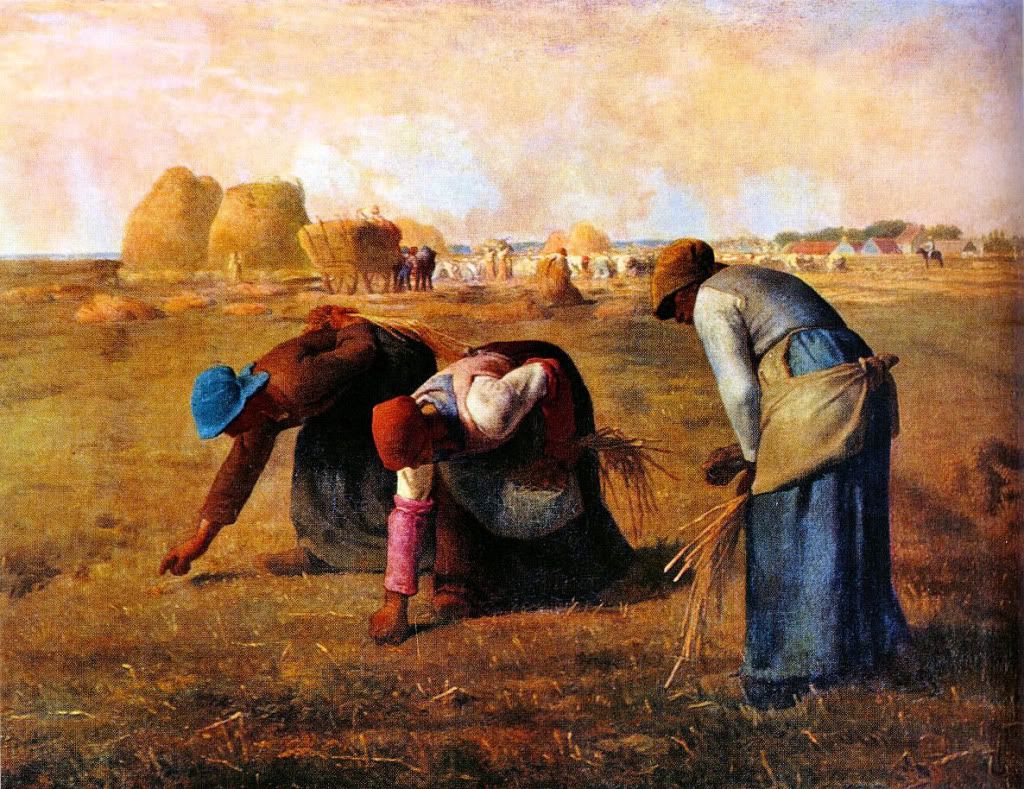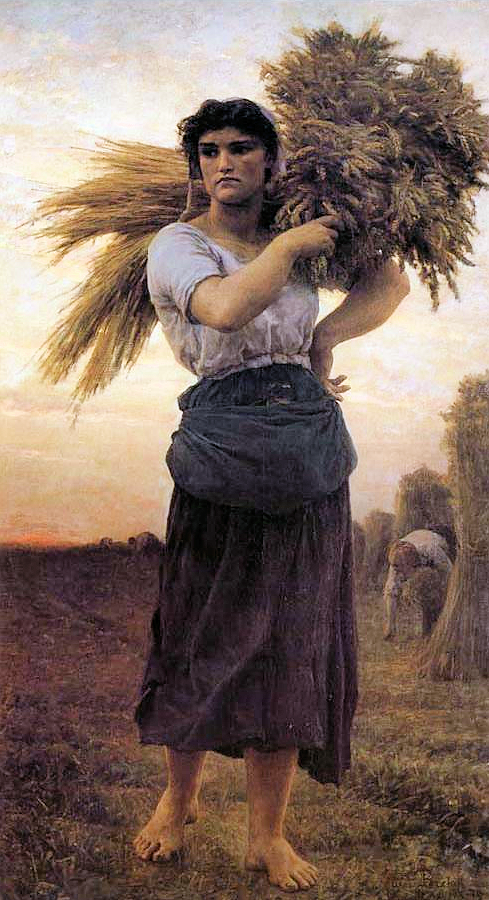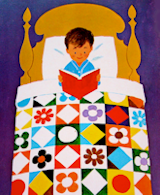A STORY OF HARVEST TIME
BEFORE the sun had risen above the hills, and while yet the dew lingered on the grass, the harvesters were at their work. With their hook-shaped sickles they cut the grain, handful by handful, and laid it in uneven swaths upon the ground; and as they kept time with one another they chanted a song of thanksgiving and praise to the sender of the harvest, the giver of good gifts, the Lord of earth and sky. After them came the boys and young men who had not learned to handle the sickle,— some to gather the swaths up into bundles and others to bind the bundles into sheaves.
Following these were the gleaners, the poor people of the village, and the strangers who were without homes in the land; for it was a law of that county try that all the loose grain that was upon the ground and all that was left uncut by the reapers should belong to the needy and homeless. —James Baldwin.
Read this selection over carefully.
- What do the words, above the hills, help you to picture?
- Tell how the sky would look before the sun had risen.
- How would the air feel?
- What sounds would you hear?
- Do you think the harvesters noticed these things?
- Describe the way in which the grain was cut.
- Tell how the reapers kept time with one another.
- In what way may the chanting of a song have helped them?
- Why was the song one of thanksgiving and praise?
- Describe the work of the young men and boys.
- Tell who the gleaners were in this country.
- What did they do? Tell what the law of the country gave to them.
- What do you think about such a law?
(Source: Language Lessons by John Benjamin Wisely)
Sensier's Interpretation of Millet: "For Millet, the man of soil, represents the whole human family; the laborer gave him the clearest type of our toil and our suffering. Millet is, however, neither a discouraged nor a sad man. He is a laborer who loves his field — ploughs, sows, and reaps it. His field is art. His inspiration is life, is nature, which he loved with all his strength. . . . And if before a painting or a drawing by Millet, we are shocked by the roughness of his hand, the unusualness of his subject, the unexpectedness of his composition, let time do its work. Let us go and look at the plains, the forest, and the sky; let us forget our fashions and our traditions, and we will feel the same strengthening breath that animated Millet. . . . He that understands him will say, Here is a painter who has given a place to the humblest; a poet who has raised to honor those whom the world ignores, and a good man, whose work encourages and consoles."
Jean-Francois Millet (1814-1875) was the son of poor French peasants. His father was a man of beautiful character, a natural musician, and a lover of nature. He said to his son often, " Look at that tree, how large and beautiful; it is as beautiful as a flower," or "See! That house buried by the field is good; it seems to me that it ought to be drawn that way." He tried sometimes to model in clay or to carve a bit of wood. But he died ignorant of his own worth and gifts.
Millet's grandmother named him Jean for his father and Francois for that charming Saint Francis of Assisi, whom even the birds loved and to whom they talked. She loved her little godson and grandson, rocking, caring for him, and singing to him all day long. In the morning she wakened him gently with, "Wake up, my little one; you do not know how long the birds have been singing the glory of God!"
The little Millet was a handsome, hearty, strong lad, quite able to hold his own against the other boys both with his fists and his head. The clergyman of the village taught him Latin for the pleasure of it, and he studied it for the same reason.
His father sympathized with his craze for drawing and helped him to find his first master. Finally, Millet went to Paris, and there entered the studio of the famous painter, Paul Delaroche. The city students could not understand him. They nicknamed him the "Man of the Woods"; but they soon learned that he could draw. " It is easy to see that you have painted a great deal," said Delaroche. But he had never touched the brush before.
Nevertheless he had a hard struggle to get along. His pictures did not sell. He was ready to print signboards even, but the market for them was not inexhaustible. At last he moved from Paris to Barbizon, where he lived and worked for the rest of his life.
At first a small peasant house with three rooms answered for his wife and three children, but as his family increased the house was lengthened, and a studio, wash-house, and chicken-yard built in the garden.
"He had two occupations," writes Sensier; "in the morning he dug or planted, sowed or reaped; after lunch he went into the low, dark, cold room called a studio. . . . His first vision was a Bible subject, Ruth and Boaz, which he drew on the wall in crayon."
Here for years he was wretchedly poor. "But," said he, "let no one think that they can force me to prettify my types; I would rather do nothing than express myself feebly. Give me signboards to paint; give me yards of canvas to cover by the day like a house painter, but let me imagine and execute my own work in my own way."
But recognition came to him at last and in his own lifetime. The knowledge of him, and reverence and love for his teaching have been increasing ever since his death.
Method.— What do you think that the girl in the foreground is saying? What are the others in her group doing? What is she carrying in her left hand? Why? What do you make out of the group toward the right? of the left background? Where is the sun? How do you know? What is the time of day? the season of the year? the country? (Source: Picture Study in Elementary Schools by Williams Wilson; Story and Notes)
The Gleaner by Jules Breton
(Click on image to enlarge)
The picture is a favorite with the painter. "Ceres of France" he calls it in one of his poems. "How royally," he says, "is the golden wheat carried on thy shoulder."
"Jules Breton wrote many poems, and a vein of poetry runs through his pictures. They tell of the sadness of the land when the fields sleep dreamily beneath the shadows of the evening, touched by the last rays of the setting sun; but they tell of it in verses where the same rhymes are repeated with wearisome monotony." — Richard Mather.
Jules Breton (1827- ), one of the most popular of living French artists, was born of wealthy, intelligent parents. His mother died when he was but four years old, so his uncle, a genuine nature lover, came to live with his father and helped to bring up Jules and the other children. At the age of six Jules determined to be an artist. This was the more remarkable in that there was no art in his native town. The only painting that he had ever seen was the restoration, by means of bright green paint, of the four statues of the seasons which adorned his father's grounds. This made upon him so vivid an impression that in later years he wrote a poem in commemoration. He was sent to a religious school at the age of ten. While there he made a drawing of a favorite black dog named Coco, representing him in a cassock on his hind feet with a book in his paws. Underneath he wrote, "The Abbe Coco reads His Breviary." Unfortunately this was seen by one of his teachers. "Did you do this through impiety or to laugh at your masters?" he asked. Poor little Jules did not know at all why he had done it. He only knew that it was certainly wrong to laugh at his masters, and so he answered, trembling, "Through impiety." His master whipped him. These undeserved blows caused his family to send him to another school, where, fortunately, the atmosphere was more favorable to his artistic ambitions.
He has always been a hard worker, and his great successes have been well earned. His brother, Emile, and his daughter, Madame Demont-Breton, whose picture of the "Frightened Bather" will be remembered, are both his pupils, and both excellent artists.
Method. — Secure, if possible, a large framed copy for the room and smaller copies for each of the pupil's desks.
The message of this picture is the beauty, the dignity of labor, the health and real wealth that it brings. Therefore, let the study of the picture be preceded by the nature study for the month, by the thoughtful reading of such poems as his magnificent "Songs of Labor," "At Harvest Time," from "Lilliput Levee," etc.
Let the children give their own interpretation, but direct their observation, and thought, too, by leading questions, as they may be necessary.
Of whom is this a picture? What is she doing? What was she doing? How do you know? What time of the year is it? (July.) Why do you think so? Is it hard work or easy work for the girl? Would you find it hard or easy? Why? How would you carry the large sheaf? What will become of the wheat? Why is she barefoot? Was the picture painted in this country? Why do you think not? 1 Who painted the picture? Why did he call her "Ceres of France"? Does she look like a goddess? How? Why? What other harvest pictures have you ever seen?
Stimulate the children to bring other pictures for a loan collection.
Just as soon as possible let them have the keen pleasure and great intellectual stimulus of deciding which picture of several they like the best, and why they prefer it to the others.
The teacher must remember that it is impossible to force into the consciousness of the children artistic feeling, knowledge, and wisdom. Its development and growth is from within outward; therefore it is not a bad plan to let the children shape the course within reasonable limits. Show them either a number of Breton's pictures, or else
Select a number of harvest pictures by other artists. Put them about the room. Then let the children choose each for him or herself which one she wishes to keep on her desk for a day. Give them the opportunity thus silently to study several.
It is a good plan to let the children write an account of the artist or the picture, or both. Give them each a copy of the picture, thus starting them with an art note-book, to which should be added the appropriate poems; or, if possible, give them each the opportunity to buy the picture, or, if nothing better can be done, openly start a note-book of your own in the hope that some of them will feel disposed to follow your example.
(Source: Picture Study in Elementary Schools by Williams Wilson)
Labels: Art
1 Comment:
-
- Mom31257 said...
September 11, 2010 at 10:09 AMSounds like a full and good week. I hope you find peace about your decision with ps. I'd like to read more about the morning basket idea.
Subscribe to:
Post Comments (Atom)























